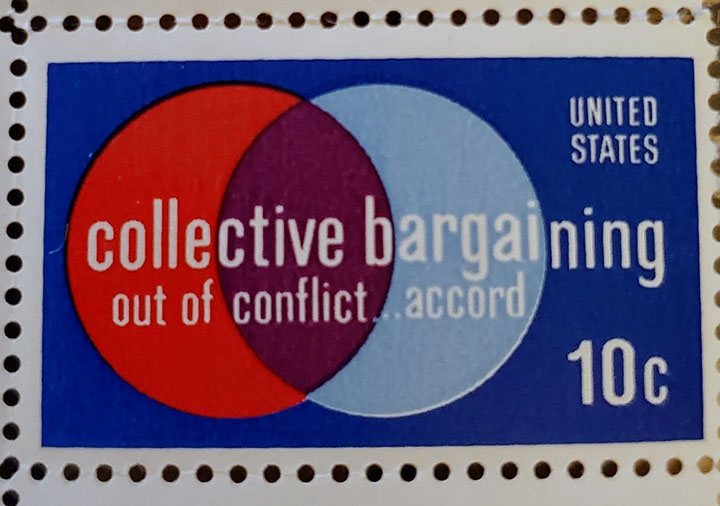Select any filter and click on Apply to see results
Article 21: Equal Employment Opportunity
Section 1
A. The Employer and the Union recognize that discrimination prohibited by equal employment opportunity (EEO) law, including harassment, undermines the integrity of the employment relationship and adversely affects employee opportunities. All employees must be allowed to work in an environment free from discrimination. Therefore, the Parties agree to identify and work to eliminate any such occurrences.
B. The Employer and the Union recognize that no employee may discriminate against others based on race, color, religion, sex, national origin, age (40 or more), sexual orientation, disability, or protected genetic information (as defined in Executive Order 13145, dated 02-08-2000).
C. The Employer and the Union, in fulfilling their respective responsibilities, commit to providing each employee equal opportunity regardless of the employee's race, color, religion, sex, national origin, age (40 or more), sexual orientation, disability, or protected genetic information.
D. The Employer and the Union, in fulfilling their respective and distinct responsibilities, will strive to bring about the informal resolution of complaints, wherever possible.
Section 2
The Employer's Equal Employment Opportunity Program shall be designed, implemented, and administered by the Employer in accordance with applicable laws, rules, regulations, and this Article.
Section 3
A. The Employer and the Union shall maintain an EEO committee to discuss relevant equal employment opportunity issues of general applicability to employees, including those concerning minorities, women, and employees with disabilities. Such issues will not include the discussion of individual EEO complaints. The Union will designate its representatives, not to exceed the number designated by the Employer. The committee shall be co-chaired by an Employer representative and a Union representative. The Union and Employer co-chairs will alternate responsibility for scheduling mandatory meetings and will jointly be responsible for setting the agendas and chairing the meetings. The committee shall meet within ninety (90) days of the effective date of this Agreement, and at least semi-annually thereafter. Upon agreement of the co-chairs, the committee may meet more frequently. The committee will make recommendations to the EEO Director for their consideration. A meeting of the EEO committee may be called by either the Union or the Employer.
B. The Employer will provide the Union a summary of EEO-office activities on a quarterly basis.
Section 4
A. Each year that this Agreement is in effect, the Employer will provide the Union with copies of the most recently filed annual EEO program reports required by the EEOC's Management Directive 715 ("MD-715").
B. In accordance with the Notification and Federal Employee Antidiscrimination and Retaliation Act of 2002 (No FEAR Act), the Employer will post on its public web site information each Fiscal Year on the aggregate numbers and types of EEO discrimination complaints filed that year against the Employer. These reports shall not include information that would reveal the identities/positions of individuals.
Section 5
Each year of this Agreement, the Employer will provide each NTEU Chapter 293 steward not less than two (2) hours of administrative leave for training on EEO matters.
Section 6
Upon reasonable notice, the Employer will provide all EEO counselors with a private place to meet with an employee for counseling purposes.
Section 7
A claim involving discrimination based upon race, color, religion, sex, national origin, age (40 or more), sexual orientation, disability, or protected genetic information may, at the discretion of the employee, be raised either under the Employer's EEO administrative complaint process or through the grievance procedure provided in Article 32 (Grievance Procedure) of this Agreement, but not both. Pursuant to 5 U.S.C. § 7121(d), an employee will be deemed to have exercised their option to raise a matter either under the Employer's EEO administrative complaint process or under the negotiated grievance procedure at such time as the employee timely files a formal complaint of discrimination or timely files a grievance in writing in accordance with the provisions of Article 32 of this Agreement, whichever event occurs first. Consultation with an EEO counselor does not constitute filing a formal EEO complaint.
Section 8
A. Any employee seeking to file an EEO administrative complaint, or any employee participating in the Employer's administrative complaint process, shall be free from restraint, coercion, interference, or reprisal.
B. If a complaint is filed, the employee shall have the right to be accompanied, represented, and advised by a personally chosen representative when there is no apparent or actual conflict of interest. Both the employee and the employee's representative, if either is in an active duty status, shall be afforded a reasonable amount of Official Time for the initial preparation of the employee's complaint, as well as for each subsequent step of the complaint procedure. This time shall be requested in writing and approved prior to use.
C. The Employer will carefully consider and process all complaints of discrimination filed through the EEO administrative complaint process or through the negotiated grievance procedure, and will do so justly and expeditiously.
Section 9
The Employer recognizes its obligation under the Rehabilitation Act of 1973, as amended, to "reasonably accommodate" qualified employees and applicants with disabilities. It also recognizes its obligations under all other relevant EEO statutes.
Section 10
The Employer will provide briefings to the Union, through its Office of Equal Employment Opportunity, regarding barrier analyses that affect bargaining unit employees or bargaining unit positions. The topics of the briefings will include: significant statistical triggers; any changes to the barrier analysis research agenda; the conclusions and recommendations of completed barrier analysis studies; Union participation in any focus groups of bargaining unit employees; and subject matters on which the Parties mutually agree that the Union’s input would be beneficial. The Employer will also provide appropriate reports regarding the Agency’s final analysis in advance of each briefing for the Union to review. The Union may provide its own response to the Employer regarding barrier analyses’ conclusions and recommendations.

